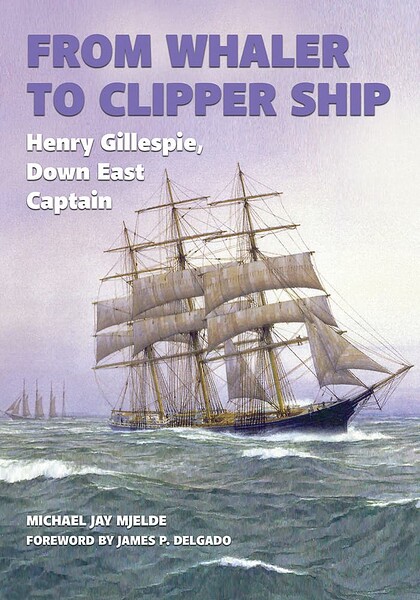Looking for a good read? Here is a recommendation. I have an unusual approach to reviewing books. I review books I feel merit a review. Each review is an opportunity to recommend a book. If I do not think a book is worth reading, I find another book to review. You do not have to agree with everything every author has written (I do not), but the fiction I review is entertaining (and often thought-provoking) and the non-fiction contain ideas worth reading.
Book Review
A Biography of Clipper Ship Captain Henry Gillespie
Reviewed by Mark Lardas
March 3, 2024
“From Whaler to Clipper Ship: Henry Gillespie, Down East Captain,” by Michael Jay Mjelde, Texas A&M University Press, July 2023, 456 pages, $80.00 (Hardcover), $35.00 (Ebook)
Henry Gillespie was a Maine native. His parents owned and ran boarding houses, hotels and saloons. Henry chose another path. In 1874 he became a sailor, signing aboard a whaler at age 18.
“From Whaler to Clipper Ship: Henry Gillespie, Down East Captain,” by Michael Jay Mjelde, tells what happened next. The book, a biography of Gillespie’s life, also follows the history of the United States merchant marine over half a century, from 1874 through 1921, when Gillespie finally retired.
A period of great change at sea, Gillespie took part in that change. In 1874, when Gillespie signed as an able-bodied seaman aboard whaler Wave, most of the American merchant fleet was made up of sailing ships. In 1921, when he retired as captain of the 12,000 deadweight ton tanker SS Swiftsure, most of the windjammers had retired and steamships ruled.
Mjelde follows Gillespie’s transition from a raw beginner to a respected merchant ship’s captain. Gillespie lied about his experience to be rated able-bodied on Wave. He was derated, ridiculed and humiliated in front of his shipmates, and deserted at Barbados. Despite this bad start, he stuck with the sea. Shipping on other sailing vessels (although never another whaler) he gained experience, eventually becoming a ship’s officer.
He became a “bully” officer and later captain, one who ran his ship through brutality. Because of his competence, the ships’ owners who hired him overlooked this. His brutality led to a court action which could have beached him. Following marriage he reformed. His wife, who frequently sailed with him, smoothed off his rough edges, and he became an exemplary officer, mostly sailing out of San Francisco.
While he eventually made the transition from sail to steam, the pinnacle of his career was in sailing ships. He gained command of medium clipper Glory of the Seas in 1906. This was a legendary vessel. Launched in 1869 it was the last ship designed by famed marine architect Donald McKay. About to become a barge, it was restored following the San Francisco earthquake to bring lumber to rebuild the city.
“From Whaler to Clipper Ship” is a wonderful window on the late 19th and early 20th century, and not just at sea. It captures America during its Gilded Age and transformation into a world power. It shows San Francisco at its raucous peak, and tells a fascinating story of an iron man commanding wooden ships.
Mark Lardas, an engineer, freelance writer, historian, and model-maker, lives in League City, TX. His website is marklardas.com. This review appeared in a different form in Epoch Times.
